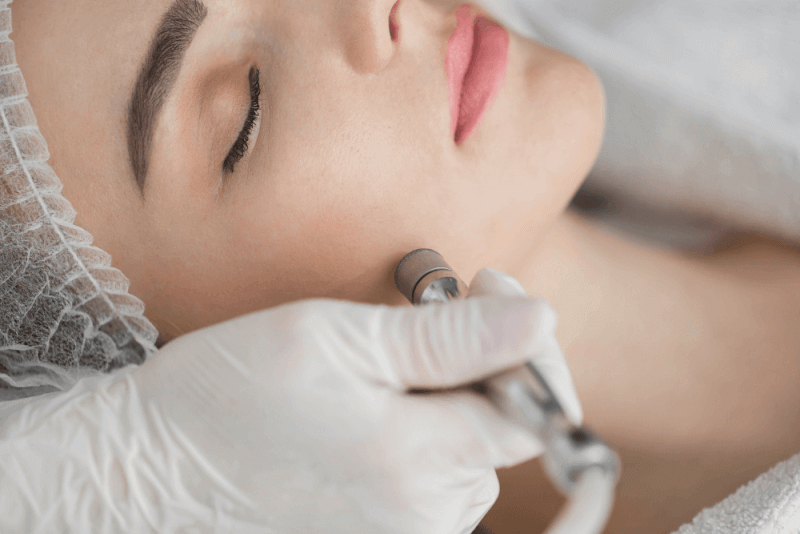30-Second Summary
- Meaning “black tumor,” melanoma is the most dangerous type of skin cancer. This rapidly progressing cancer has a high risk of metastasis.
- Melanoma occurs when a factor transforms healthy melanocytes into cancer cells.
- Melanoma does not always start as a mole. It can appear on healthy skin. Symptoms of melanoma can appear anywhere on the body, especially in areas most exposed to the sun.
- After a melanoma diagnosis, staging is essential for determining the appropriate treatment.
What Is Melanoma?
Meaning “black tumor,” melanoma is the most dangerous type of skin cancer. This rapidly progressing cancer has a high risk of metastasis. Melanoma starts in skin cells called melanocytes and is usually black or brown in color, but it can also appear purple, red, skin-colored, or pink.
Melanocytes are the cells responsible for giving color to the skin. About 30% of melanomas begin in moles. However, the rest develop on normal skin. Therefore, it is crucial to pay attention to changes in the skin. Knowing how many moles are present also helps estimate the risk of developing skin cancer.
Knowing whether the risk for melanoma is high is very important since it is a dangerous cancer. Due to its rapid progression, delayed treatment can be the difference between life and death. Being aware of the risk allows for early diagnosis and treatment. When diagnosed at an early stage, the treatment success rate is 99%.
Types of Melanoma
Melanomas are classified into various types based on their location, growth rate, and symptoms. These types include:
Superficial Spreading Melanoma
The most common type of melanoma, superficial spreading melanoma accounts for 70% of all cases. It begins in the upper layers of the skin and over time spreads to the deeper layers.
Superficial spreading melanoma can occur in adults of any age but is more common in individuals under the age of 40.
While sun exposure and tanning beds are the most common causes, other factors can also lead to superficial spreading melanoma. Its characteristic sign is an unusual spot in terms of size or appearance.
Nodular Melanoma
Nodular melanoma is the fastest-growing type of melanoma. It typically grows rapidly within a few weeks or months. It may appear on the surface of the skin or in the deeper layers. This cancer type tends to grow vertically and may form beneath the surface like an iceberg.
Lentigo Maligna Melanoma
Commonly seen in older adults, this melanoma type develops particularly in chronically sun-damaged skin in the head and neck region. Lentigo maligna melanoma, also known today as melanoma in situ, usually appears as irregular brown spots on sun-damaged skin. It is typically confined to the epidermis and referred to as LM. If the lesion becomes invasive, it is called LMM.
Acral Lentiginous Melanoma
Also known as ALM, acral lentiginous melanoma appears on the palms, soles, or under the nails. Although rare, it is the most common type of melanoma among Asian and dark-skinned individuals.
Mucosal Melanoma
A rare type of melanoma, mucosal melanoma begins in the mucosa, one of the soft tissues that line internal organs. Therefore, it can occur in any area containing mucosal tissue. The most commonly affected regions include:
- Head and neck area, especially the nose, lips, and mouth
- Anus and rectum
- Vagina and vulva
Desmoplastic Melanoma
One of the melanoma types that starts in melanocytes, desmoplastic melanoma is an invasive type of cancer. Because it often involves nerve fibers, it is also known as neurotropic melanoma. In some cases, it emerges as part of lentigo maligna melanoma.
Causes of Melanoma
Melanoma occurs when a trigger causes healthy melanocytes to turn into cancer cells. These cells, also known as pigmented melanins due to their role in giving color to the skin, undergo changes in their DNA. Melanoma begins when melanocytes develop alterations in their DNA. A cell’s DNA contains the instructions that tell it what to do.
In healthy cells, DNA gives instructions for cells to grow and divide at a controlled rate. These instructions also tell cells when to die. Changes in this system cause cancer cells to grow uncontrollably. Cancer cells may live when healthy cells would normally die. As a result, the number of cells increases.
Cancer cells may form masses called tumors. A tumor continues to grow, invading and destroying healthy body tissue. Over time, cancer cells can break away and spread to other areas of the body. When cancer spreads, it is called metastatic cancer.
It is not entirely clear what causes changes in skin cell DNA or how this leads to melanoma. It is likely that a combination of factors—including environmental and genetic elements—play a role. Still, researchers believe that exposure to ultraviolet (UV) light is one of the leading causes of melanoma.
Risk Factors for Melanoma
Factors that may increase the risk of melanoma include:
Family History
Having a close relative with melanoma increases the risk of developing it. Close relatives include siblings, parents, or children.
History of Sunburn
One or more blistering sunburns can increase the risk of developing melanoma.
Exposure to UV Radiation
UV rays from the sun and tanning devices increase the risk of melanoma and other types of skin cancer.
Having Many Moles or Atypical Moles
Having more than 50 typical moles may indicate a higher risk for melanoma. Also, having atypical moles, medically known as dysplastic nevi, which tend to be larger and have irregular borders or color patterns, increases the risk.
Living Closer to the Equator or at a Higher Elevation
People living near the equator receive more direct sunlight than those living farther north. Similarly, those living at higher altitudes are exposed to more UV radiation.
Fair Skin That Burns Easily
Although melanoma can occur in anyone, it is more common in people with fair skin. Those with blond or red hair, light-colored eyes, and freckles are at higher risk.
Weakened Immune System
A weakened immune system due to diseases or medications increases the risk of melanoma and other skin cancers. This includes people taking immunosuppressive drugs for organ transplants or those with medical conditions such as HIV.
Symptoms of Melanoma
The initial signs of melanoma typically include the following:
- Changes in an existing mole
- Development of a new pigmented or unusual-looking growth on the skin
Melanoma does not always start as a mole. It can also develop on healthy skin. Melanoma symptoms may appear anywhere on the body, and these areas are often those most exposed to the sun, such as the arms, back, face, and legs.
Melanomas can also occur in areas with little sun exposure, such as the soles of the feet, palms of the hands, and under the nails. Melanoma can even develop inside the body. These hidden melanomas are more common in people with brown or black skin.
Typical Moles
Typical moles generally have a uniform color. They can appear pink, skin-colored, brown, or black. In people with darker skin, moles may also be darker. Typical moles usually have a clear border that separates them from the surrounding skin. They tend to be oval or round in shape and are typically smaller than 6 millimeters.
Typical moles often appear during childhood and may continue to form until around age 40. Adults typically have between 10 and 40 moles. Over time, moles may change in appearance or even disappear with age.
Signs That May Indicate Melanoma
Some moles may appear atypical and exhibit features that are suggestive of melanoma or other types of skin cancer. These features may include:
- Two halves of the mole that look very different from each other
- Presence of multiple colors or unusual color patterns
- A diameter larger than approximately 6 millimeters
- Symptoms such as itching or bleeding
- Irregular, jagged, or notched borders
Not all cancerous moles look the same. Some may display all of the changes listed above, while others may only show one unusual feature.
Hidden Melanomas
Melanomas can also develop in areas of the body that are not frequently exposed to the sun. These areas include between the toes, palms of the hands, soles of the feet, scalp, or genital areas. These are sometimes called hidden melanomas because people often do not think to check these locations. Since melanomas are more likely to occur in individuals with brown or black skin, they are more likely to be found in hidden areas.
Types of hidden melanomas include:
- Mucosal melanoma is particularly difficult to detect because it can be mistaken for more common conditions.
- Ocular melanoma, also known as eye melanoma, usually appears in the white part of the eye and can cause visual changes. It is often detected during an eye exam.
- Subungual melanoma, which occurs under the nail, usually appears as a very dark spot with irregular borders.
Melanoma Diagnosis Criteria
Tests and procedures used to diagnose melanoma include the following:
Physical Examination
Doctors ask patients about their medical history and perform a physical examination to check for signs of melanoma.
Biopsy
A biopsy involves removing a sample of tissue for laboratory testing. Doctors often remove the entire growth. The most common biopsy technique is a punch biopsy, which uses a circular blade to remove the mole and some surrounding tissue.
Another method is an excisional biopsy, where a scalpel is used to cut out the entire mole along with a margin of surrounding skin.
Tests for Staging
Once melanoma is diagnosed, tests are performed to determine the stage of the cancer. These tests include the following:
Sentinel Lymph Node Biopsy
For melanomas deeper than 0.8 mm, or for tumors with ulceration or concerning microscopic features, a sentinel lymph node biopsy may be needed to determine if the cancer has spread. Studies have shown that survival rates are higher in patients diagnosed with sentinel lymph node biopsy compared to those diagnosed with physical exam alone.
CT Scan
CT scans are used to check for the spread of melanoma to internal organs.
MRI
MRIs help examine whether the melanoma has spread to the brain or spinal cord.
PET Scan
PET scans are used to detect melanoma that may have spread to lymph nodes far from the original site or to other parts of the body.
Blood Tests
Blood tests may be performed to measure LDH (lactate dehydrogenase) levels before treatment. Other tests include checking blood chemistry and cell counts.
Staging
After a melanoma diagnosis, determining the stage of the disease is essential for choosing the appropriate treatment. During staging, doctors consider the following factors:
Determining Thickness
In general, the thicker the melanoma, the more serious the disease. Thickness is measured under a microscope using a special tool. The thickness of the melanoma helps determine treatment plans.
Thin melanomas may only require surgery to remove the cancer and some surrounding healthy tissue. If the melanoma is thicker, additional tests may be needed to check if the cancer has spread before deciding on further treatments.
Checking for Spread to Lymph Nodes
If there is a risk of the cancer spreading to nearby lymph nodes, a sentinel lymph node biopsy is performed.
Looking for Cancer Beyond the Skin
If there is concern that melanoma has spread, imaging tests are used to check for signs of cancer in other parts of the body.
Other factors that help determine the risk of cancer spread include whether the skin is ulcerated and how many dividing cancer cells (mitotic rate) are seen under a microscope.
Melanoma Treatment Methods
Melanoma treatment varies depending on the stage of cancer and the patient’s overall health. Treatment usually begins with surgery to remove the cancer, but radiation, chemotherapy, and other therapies may also be used. The main treatment options include:
Surgery
Surgery is the primary treatment for melanoma. Thin melanomas may be completely removed during a biopsy and may not require further treatment. In other cases, surgeons remove the cancerous tissue and some surrounding healthy skin.
For patients with small and thin melanomas, surgery may be the only required treatment. If melanoma has spread deeper into the skin, there is a greater chance it has spread to other parts of the body, requiring additional treatments.
Lymphadenectomy
If melanoma has spread, nearby lymph nodes may need to be removed to prevent further spread throughout the body.
Metastasectomy
This procedure is used to remove small melanoma lesions found in other organs.
Radiation Therapy
Radiation therapy treats cancer by using powerful energy beams. These beams may come from X-rays, protons, or other sources. During radiation treatment, a machine rotates around the patient and directs the energy beams to specific parts of the body.
If melanoma has spread to the lymph nodes, radiation therapy may be directed to those lymph nodes. It may also be used when the melanoma cannot be completely removed by surgery. In cases where melanoma has spread to other parts of the body, radiation may help relieve symptoms.
Immunotherapy
Immunotherapy for cancer involves using medications that help the body’s immune system kill cancer cells. The immune system fights diseases by attacking harmful cells, including cancer. However, cancer cells can survive by hiding from the immune system. Immunotherapy helps the immune system recognize and destroy these cancer cells.
In melanoma, immunotherapy may be injected directly into the mole or lymph nodes.
Targeted Therapy
Targeted therapy for cancer uses medications that attack specific chemicals within cancer cells. By blocking these chemicals, targeted therapies can help kill the cancer cells.
Targeted therapy may be recommended when melanoma has spread to lymph nodes or other parts of the body. Cancer cells taken from the melanoma are tested to determine whether targeted therapy will be effective.
Chemotherapy
Chemotherapy treats cancer using powerful medications, usually given through a vein (intravenously). In some cases, chemotherapy drugs may be taken orally as pills. Chemotherapy is generally used when other treatment options are not effective.
In some cases, chemotherapy is delivered using a technique called isolated limb perfusion, in which the drugs are infused into a vein in the arm or leg. During this procedure, blood flow between the treated limb and the rest of the body is temporarily restricted. This helps concentrate the medication around the melanoma and limit its effects on the rest of the body.
Ways to Prevent Melanoma
Paying attention to the following points can help reduce the risk of developing melanoma and other types of skin cancer:
- Avoiding tanning beds
- Avoiding sun exposure between 10:00 AM and 4:00 PM
- Frequently checking your skin to quickly identify any changes
- Wearing protective clothing when exposed to sunlight
- Using sunscreen year-round
Difference Between Melanoma and Skin Cancer
Melanoma is one type of skin cancer. Non-melanoma skin cancers refer to cancers that originate from basal cells, squamous cells, or Merkel cells. Melanoma, on the other hand, is a cancer that develops in the skin’s melanocytes.







